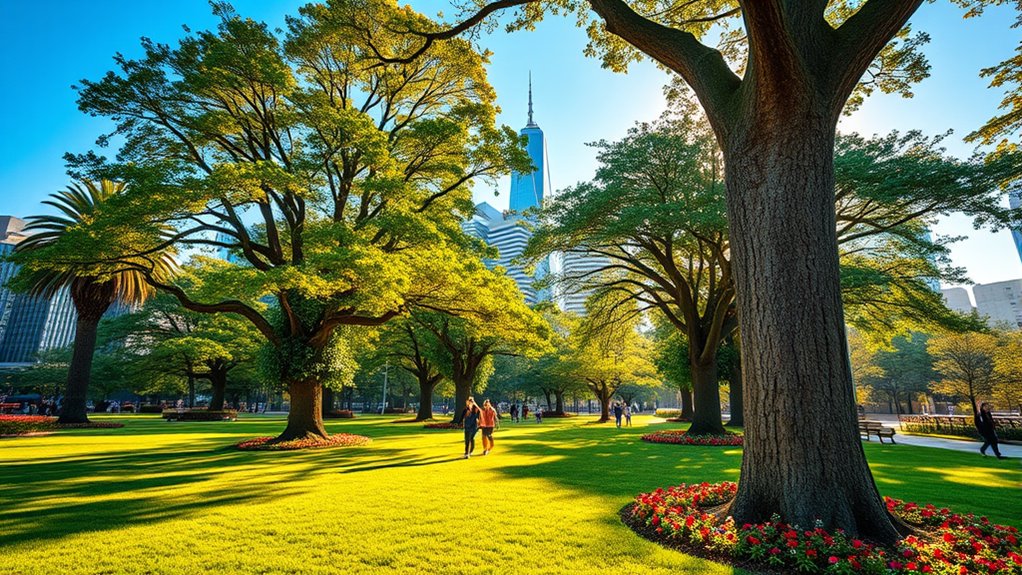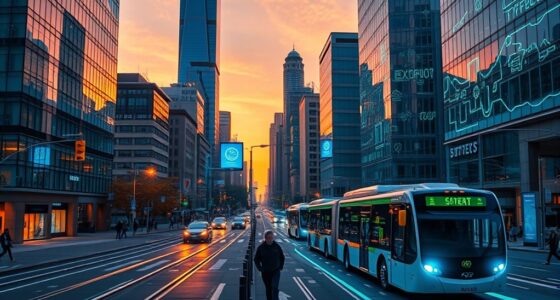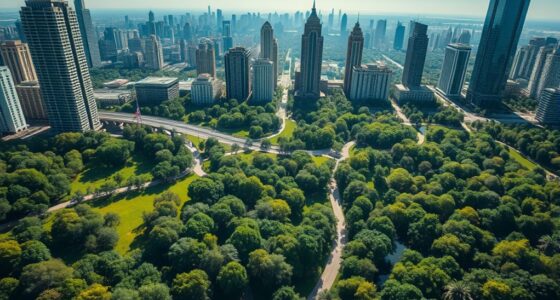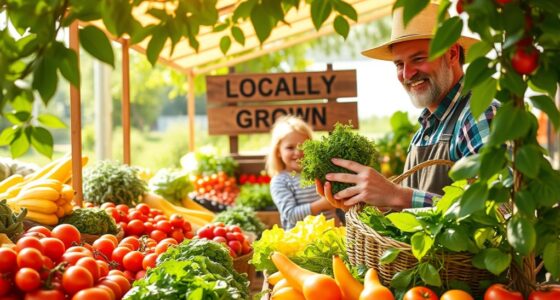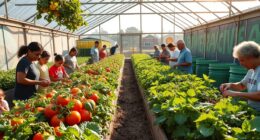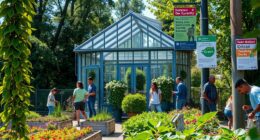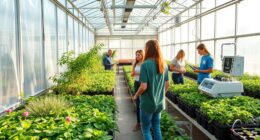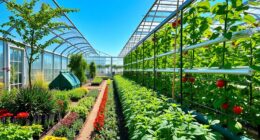Green spaces in cities play a crucial role in boosting your health and supporting sustainability. They provide clean air, reduce urban heat, and manage stormwater, making your environment more livable. Parks also support local biodiversity, helping pollinators, birds, and small mammals thrive alongside you. Access to these areas encourages outdoor activity and social interaction, which improves mental and physical well-being. If you’re curious about how these green spaces shape better cities, there’s more to explore.
Key Takeaways
- Green spaces promote physical activity, mental well-being, and social interaction, enhancing overall urban health.
- Urban biodiversity supports ecosystems, pollinators, and helps maintain ecological balance.
- Accessible parks reduce health disparities and improve quality of life for underserved communities.
- Green infrastructure manages stormwater, reduces heat islands, and improves air quality for sustainable cities.
- Community engagement in green spaces fosters social cohesion and environmental stewardship.

Have you ever wondered why parks and green spaces are essential to urban life? These areas aren’t just pretty spots to relax; they play a critical role in shaping healthier, more sustainable cities. One key aspect is urban biodiversity, which refers to the variety of plants, animals, and microorganisms thriving within city environments. When you visit a park, you’re witnessing a tiny ecosystem that supports pollinators like bees and butterflies, birds, and even small mammals. These creatures contribute to maintaining ecological balance and enhancing the overall health of urban areas. By preserving and expanding green spaces, city planners can boost urban biodiversity, creating resilient environments that withstand climate change and reduce pollution. Additionally, the presence of diverse plant species can improve soil quality and help mitigate urban heat island effects, making cities more livable. Accessibility to green spaces is equally important. When parks are easy for everyone to reach—whether you live downtown or in the suburbs—you’re more likely to get outside, exercise, and enjoy nature. Green space accessibility isn’t just about proximity; it also involves safe pathways, inclusive design, and equitable distribution across neighborhoods. If parks are hard to access, underserved communities miss out on the numerous health benefits green spaces offer, such as reduced stress, improved mental health, and opportunities for social interaction. When you have convenient access to parks, you’re more inclined to incorporate outdoor activities into your daily routine, which can lower your risk of chronic illnesses like heart disease and diabetes. Promoting urban greenery can also foster environmental sustainability by supporting local ecosystems. As urban environments become more crowded, the integration of native plants in green spaces can further enhance biodiversity and provide habitat for local wildlife. Incorporating sustainable landscaping practices can improve the ecological value of urban parks and reduce maintenance costs. Furthermore, accessible green spaces contribute to environmental sustainability. They act as natural air filters, trapping pollutants and producing oxygen, which helps improve air quality. Trees and vegetation in parks also manage stormwater runoff, preventing flooding and reducing the burden on urban drainage systems. When parks are well-distributed and accessible, they serve as green lungs for the city, promoting a healthier environment for everyone. Creating green infrastructure within urban areas is essential for managing climate-related challenges and supporting ecological health. In addition, parks and green spaces foster community cohesion. They become gathering spots where you can connect with neighbors, participate in events, or simply enjoy the outdoors. This sense of community enhances social well-being and creates a shared responsibility for maintaining these crucial areas. As cities grow denser, prioritizing urban biodiversity and green space accessibility isn’t just a luxury—it’s a necessity. These green havens improve air quality, support diverse ecosystems, and provide equitable opportunities for all residents to enjoy nature, regardless of their background or location. By valuing and investing in parks and green spaces, you’re helping build resilient, vibrant, and healthier urban environments for generations to come.
Frequently Asked Questions
How Do Parks Impact Local Property Values?
You’ll find that parks markedly impact local property values by increasing neighborhood desirability. Properties near green spaces often enjoy higher real estate premiums because residents value the aesthetic and recreational benefits. When parks are well-maintained and accessible, they make the area more attractive, encouraging investment and boosting property prices. So, investing in parks can directly enhance your neighborhood’s appeal and increase the overall value of nearby homes.
What Are Innovative Designs for Sustainable Urban Green Spaces?
Imagine transforming city skylines into living, breathing ecosystems. You can achieve this with innovative designs like green roofs, which turn rooftops into lush gardens, and modular parks that are easily adaptable and scalable. These sustainable urban green spaces not only beautify the environment but also improve air quality and promote community well-being. By embracing these ideas, you’re helping create healthier, more resilient cities for everyone.
How Can Communities Access Funding for New Parks?
To access funding for new parks, you can explore public funding options like city, state, or federal grants dedicated to green space projects. Additionally, applying for community grants from nonprofits or local organizations can boost your chances. You should also engage your community to demonstrate support, which strengthens your grant applications. Partnering with local businesses or seeking sponsorships can provide extra financial resources, making your park project more achievable.
What Are the Best Practices for Maintaining Urban Green Spaces?
Ever wonder how you can keep urban green spaces thriving? The secret lies in best practices like native planting, which reduces maintenance and supports local ecosystems. Water conservation techniques, such as rain gardens and drip irrigation, guarantee sustainability while keeping parks lush. You can make a real difference by adopting these strategies, ensuring your green spaces stay vibrant and healthy for years to come—transforming your community into a sustainable urban oasis.
How Do Green Spaces Influence Mental Health in Urban Populations?
You’ll find that green spaces positively influence your mental health through nature therapy and stress reduction. Spending time in parks or urban green areas helps you disconnect from daily pressures, calming your mind and improving mood. These natural environments provide a restorative escape, allowing you to recharge emotionally. By integrating more green spaces into your routine, you can boost your overall well-being and resilience against urban stressors.
Conclusion
Think of parks and green spaces as the heartbeat of your city, pulsing life and energy through concrete jungles. They’re like lush lungs, breathing fresh hope into urban life, and the roots that anchor sustainability and well-being. By embracing these green oases, you’re planting seeds of health and harmony, creating a vibrant canvas where nature and community flourish side by side. Together, you nurture a city that blooms with resilience and joy.
